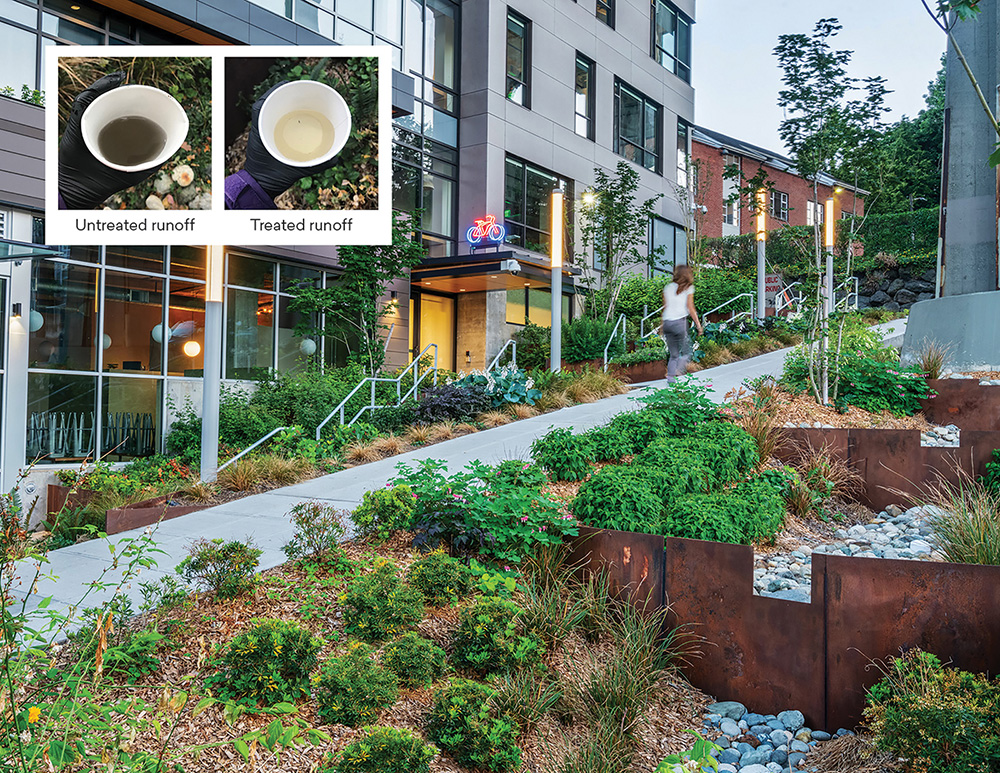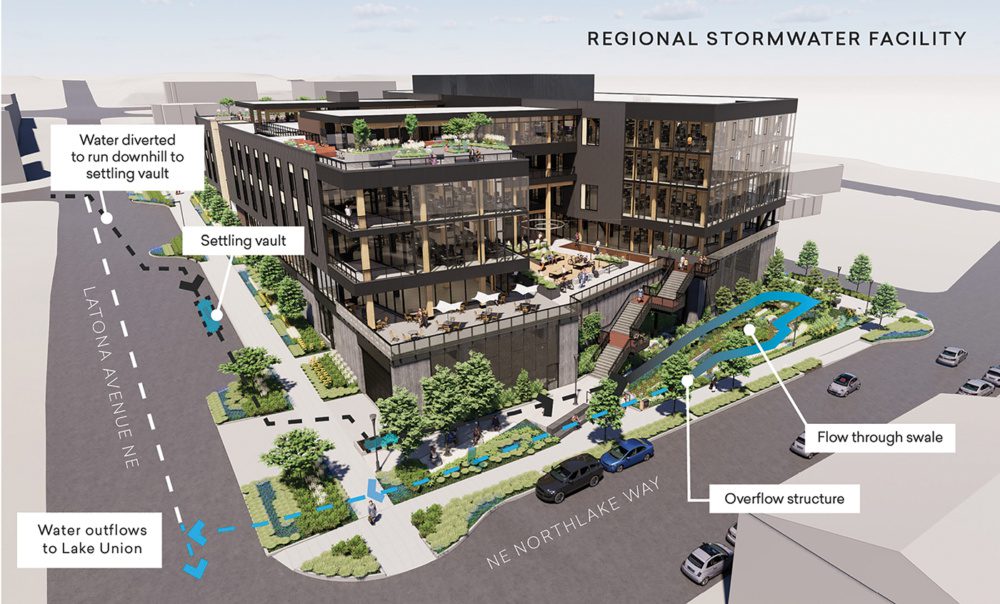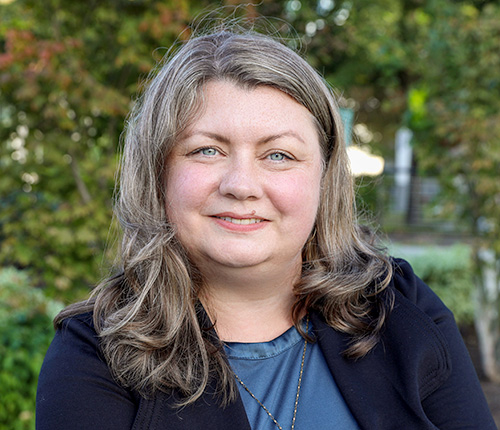By Rachael Meyer
Treated stormwater runs in Rachael Meyer’s blood. Leading Weber Thompson’s Landscape Architecture and Sustainability Design teams, she harnesses the passion of others to better our environment.
The content for this article was originally featured in the Sustainable Building & Design Section of the Daily Journal of Commerce on April 25, 2024.
Capturing and reusing rainwater onsite in new developments significantly reduces the increasing demand for our regional water supplies.
Water is life. Essential to every living thing, yet it’s often taken for granted in our urban environment. Thanks to locally-based scientific research, recent code changes, and new incentives from Seattle Public Utilities (SPU), Seattle is primed to start reversing the damage inflicted on our aquatic environment.
Private developments now have more code flexibility to collect roof water and reuse it, manage water across property lines, and expand the scope of infrastructure delivered by projects to benefit our region’s health. Given the scale and complexity of water management and pollution issues, we must act to improve water infrastructure.
Cleaning roadway runoff
For years, researchers have studied the lethal effects of stormwater on salmon populations and sought solutions for cleaning the water before it reaches salmon habitats. One solution — passing polluted stormwater through layers of soil and rock — produced promising results. Bioswales alongside DATA 1, a LEED Gold, Salmon-Safe certified building nestled under Seattle’s Aurora Bridge, applied this concept to cleaning stormwater from the bridge before it reached Lake Union.

The bioretention cell cleans and slows stormwater redirected from the Aurora Bridge.
When the swales were newly completed, the project team was tasked with collecting stormwater samples from two spots beneath the bridge. The first point collected water through a downspout directly off the bridge. This “before” sample revealed the most toxic levels researchers had seen coming off a roadway.
The second sample was collected after the bridge’s runoff was slowed and cleaned through the swales’ six stormwater retention cells. As stormwater moves through the soil, microorganisms, and bacteria latch onto the pollutants, breaking the chemicals down to their inert basic elements alongside plants that can absorb metals.
Each step cleaned 70% of the water’s toxins, resulting in virtually clear, clean water. To the team’s surprise, the effectiveness of the soil working as a sponge also meant that none of the polluted runoff reached Lake Union.
Conserving our regional water supply
The last three decades have seen great strides in water efficiency. Low-flow bathroom and kitchen fixtures are standard in new construction and water-saving practices are universally recognized as smart for both the planet and pocketbooks. In the Seattle region, we now use about the same amount of water we did in the 1950s despite the population doubling. But with drinking water supplies stressed nationally due to drought, climate change, and other factors, every drop counts.
Fremont’s Watershed office building reduces potable water usage by 75 percent from a total baseline of approximately 800,000 gallons annually. With an 11,300-square-foot roof catchment area, Watershed had the potential to capture about 300,000 gallons of rainfall annually. Low-flow fixtures and automatic timers reduced Watershed’s total water demand to about 400,000 gallons, with the remaining reduction achieved by using rainwater to flush toilets, a significant user of water in office buildings.

Northlake Commons’ regional stormwater facility goes “beyond code” to manage roughly 2.6 million gallons of runoff annually, more than twice the required volume.
At 90 percent occupancy, Watershed’s potable water usage has been measured at 105,000 gallons over a 12-month period, far below targets. In fact, despite expectations that some potable water would be needed to supplement the collected rainwater, the building has yet to use any potable water to flush toilets since its construction in 2020.
This reduction is attributed to higher-than-average rainfall, keeping the building’s 20,000-gallon cistern full more of the year, and the impact of the new hybrid workplace. Even with these factors, the results demonstrate the potential. Capturing and reusing rainwater onsite in new developments significantly reduces the increasing demand for our regional water supplies.
Mimicking nature
In Seattle, one of the biggest regional water issues is the environmental impacts of stormwater runoff. It is not enough for infrastructure to convey water into and away from buildings, it must clean and slow water and provide resilience for changing weather patterns. Our goal should be to match the attributes of the pre-existing, predominantly old-growth conifer forests, where surface runoff rarely occurred, and water moved slowly through soil before reaching streams and lakes.
Given Seattle’s rainy reputation, the city has long been a leader in stormwater management (since 2016, the Seattle Stormwater Code has required management of all stormwater that falls within the boundaries of a proposed development). Rarely, though, does this requirement address the dirtiest water in our environment, that which runs off roadways and parking lots beyond the scope of most development projects.
‘Beyond code’ partnerships
Near Fremont lies the newly constructed Northlake Commons, a lab-ready mass timber mixed-use office, retail and lumber warehouse. This project built on the aggressive storm water goals of DATA 1 and Watershed by constructing a regional swale on private property that treats stormwater that originates outside the project site and goes “beyond code” to manage roughly 2.6 million gallons annually, more than twice the required volume.
The project found potential in a nearby collector pipe that conveyed water from neighborhood roadways to Lake Union. The roads’ steep grades allowed the project to divert and daylight runoff from the collector pipe onto the Northlake Commons site. The new infrastructure channels the water via gravity through settling vaults, catch basins, a runnel and ultimately an at-grade swale before returning the water to the downhill portion of the same collector pipe.
SPU provided design support and funding to help offset the cost of the additional treatment beyond what the code required, demonstrating a new kind of partnership between public agencies and private development.
Brian Mickelson, a project manager with SPU who acted as the city liaison for Northlake Commons’ beyond code partnership, sees great potential.
“Over the last few years, SPU has been exploring partnerships as a way to complement, and build on, the strong foundation our stormwater code provides,” he said. “The Northlake Commons partnership showed that it’s possible to expand the envelope of a traditional developer project to treat several acres of stormwater from the larger neighborhood around the project site.
“The opportunity for private developers to implement and help maintain green infrastructure provides added environmental benefit at the point of redevelopment and leverages our shared investment for the public good. We hope Northlake Commons encourages more developers to come talk to us and explore the potential for ‘beyond code’ stormwater opportunities for their projects.”
This article was co-authored by Rachael Meyer and Mark Grey. Rachael is director of sustainability and landscape architecture principal at Weber Thompson. Mark Grey is founder and president of Clean Lake Union, partner at HessCallahanGrey Group, and principal at Stephen C. Grey & Associates.
